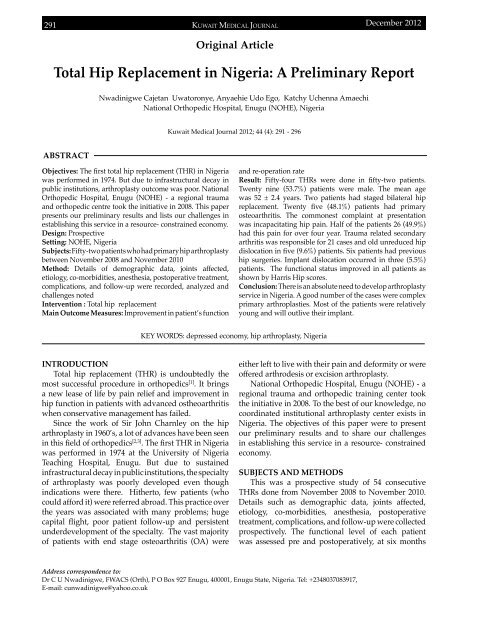Vol 44 # 4 December 2012 - Kma.org.kw
Vol 44 # 4 December 2012 - Kma.org.kw
Vol 44 # 4 December 2012 - Kma.org.kw
You also want an ePaper? Increase the reach of your titles
YUMPU automatically turns print PDFs into web optimized ePapers that Google loves.
291<br />
KUWAIT MEDICAL JOURNAL<br />
<strong>December</strong> <strong>2012</strong><br />
Original Article<br />
Total Hip Replacement in Nigeria: A Preliminary Report<br />
Nwadinigwe Cajetan Uwatoronye, Anyaehie Udo Ego, Katchy Uchenna Amaechi<br />
National Orthopedic Hospital, Enugu (NOHE), Nigeria<br />
Kuwait Medical Journal <strong>2012</strong>; <strong>44</strong> (4): 291 - 296<br />
ABSTRACT<br />
Objectives: The first total hip replacement (THR) in Nigeria<br />
was performed in 1974. But due to infrastructural decay in<br />
public institutions, arthroplasty outcome was poor. National<br />
Orthopedic Hospital, Enugu (NOHE) - a regional trauma<br />
and orthopedic centre took the initiative in 2008. This paper<br />
presents our preliminary results and lists our challenges in<br />
establishing this service in a resource- constrained economy.<br />
Design: Prospective<br />
Setting: NOHE, Nigeria<br />
Subjects: Fifty-two patients who had primary hip arthroplasty<br />
between November 2008 and November 2010<br />
Method: Details of demographic data, joints affected,<br />
etiology, co-morbidities, anesthesia, postoperative treatment,<br />
complications, and follow-up were recorded, analyzed and<br />
challenges noted<br />
Intervention : Total hip replacement<br />
Main Outcome Measures: Improvement in patient’s function<br />
and re-operation rate<br />
Result: Fifty-four THRs were done in fifty-two patients.<br />
Twenty nine (53.7%) patients were male. The mean age<br />
was 52 ± 2.4 years. Two patients had staged bilateral hip<br />
replacement. Twenty five (48.1%) patients had primary<br />
osteoarthritis. The commonest complaint at presentation<br />
was incapacitating hip pain. Half of the patients 26 (49.9%)<br />
had this pain for over four year. Trauma related secondary<br />
arthritis was responsible for 21 cases and old unreduced hip<br />
dislocation in five (9.6%) patients. Six patients had previous<br />
hip surgeries. Implant dislocation occurred in three (5.5%)<br />
patients. The functional status improved in all patients as<br />
shown by Harris Hip scores.<br />
Conclusion: There is an absolute need to develop arthroplasty<br />
service in Nigeria. A good number of the cases were complex<br />
primary arthroplasties. Most of the patients were relatively<br />
young and will outlive their implant.<br />
KEY WORDS: depressed economy, hip arthroplasty, Nigeria<br />
INTRODUCTION<br />
Total hip replacement (THR) is undoubtedly the<br />
most successful procedure in orthopedics [1] . It brings<br />
a new lease of life by pain relief and improvement in<br />
hip function in patients with advanced ostheoarthritis<br />
when conservative management has failed.<br />
Since the work of Sir John Charnley on the hip<br />
arthroplasty in 1960’s, a lot of advances have been seen<br />
in this field of orthopedics [2,3] . The first THR in Nigeria<br />
was performed in 1974 at the University of Nigeria<br />
Teaching Hospital, Enugu. But due to sustained<br />
infrastructural decay in public institutions, the specialty<br />
of arthroplasty was poorly developed even though<br />
indications were there. Hitherto, few patients (who<br />
could afford it) were referred abroad. This practice over<br />
the years was associated with many problems; huge<br />
capital flight, poor patient follow-up and persistent<br />
underdevelopment of the specialty. The vast majority<br />
of patients with end stage osteoarthritis (OA) were<br />
either left to live with their pain and deformity or were<br />
offered arthrodesis or excision arthroplasty.<br />
National Orthopedic Hospital, Enugu (NOHE) - a<br />
regional trauma and orthopedic training center took<br />
the initiative in 2008. To the best of our knowledge, no<br />
coordinated institutional arthroplasty center exists in<br />
Nigeria. The objectives of this paper were to present<br />
our preliminary results and to share our challenges<br />
in establishing this service in a resource- constrained<br />
economy.<br />
SUBJECTS AND METHODS<br />
This was a prospective study of 54 consecutive<br />
THRs done from November 2008 to November 2010.<br />
Details such as demographic data, joints affected,<br />
etiology, co-morbidities, anesthesia, postoperative<br />
treatment, complications, and follow-up were collected<br />
prospectively. The functional level of each patient<br />
was assessed pre and postoperatively, at six months<br />
Address correspondence to:<br />
Dr C U Nwadinigwe, FWACS (Orth), P O Box 927 Enugu, 400001, Enugu State, Nigeria. Tel: +2348037083917,<br />
E-mail: cunwadinigwe@yahoo.co.uk
















